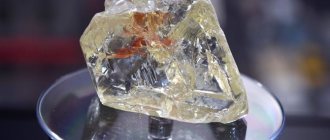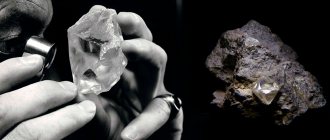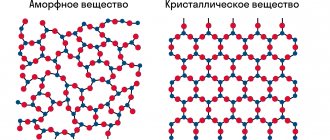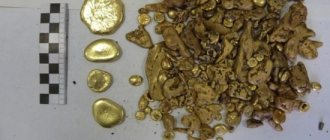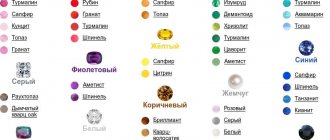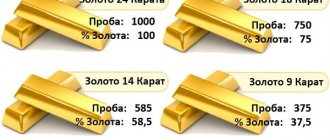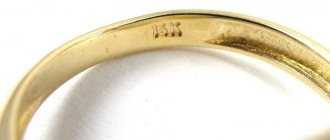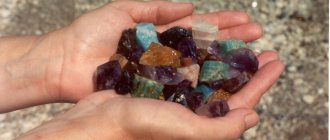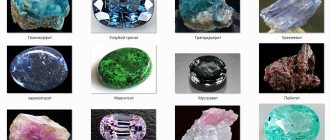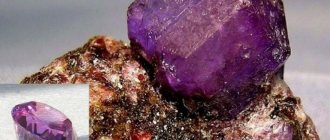| Category | Native element |
| Title in English | Diamond |
| Formula | C |
| Group | Carbon polymorphs |
| Color | Colorless, Yellow, Blue, Green, Brown, Red, Pink, Black, Blue, Gray, White |
| Stroke color | Absent |
| Shine | Diamond |
| Transparency | Transparent |
| singonia | Cubic |
| Hardness | 10 |
| Cleavage | Perfect |
| Density, g/cm³ | 3.47 - 3.55 g/cm³ |
| Kink | Conchoidal to splintery |
| origin of name | The name comes from the Greek word ἀδάμας, which translated into Russian means indestructible. This name was not chosen in vain, since diamond is the hardest type of mineral in the world. |
| Morphology | Due to the fact that diamonds dissolve in the kimberlite melt, dodecahedroid-shaped crystals appear. The formation of cuboids occurs as a result of atypical fibrous growth of diamonds. |
Diamond deposits
Diamonds are both rare and common gems.
Their deposits are found on all continents, with the exception of Antarctica. The main industrial deposits are located in Africa, Russia, Australia and Canada.
— Advertising —
The first known mines were Indian, but they were depleted at the end of the 19th century. In the 18th century, rich deposits of diamonds were discovered in Brazil. In the 19th century - in southern Africa.
In 2006, 176 million carats of diamonds were mined in the world, including $4.2 billion in Russia, $3.0 billion in Botswana, $1.7 billion in Canada, and $1.4 billion in South Africa. , in Angola for $1.2 billion.
The demand for these precious stones remains consistently high, but production is declining.
Morphology
The “50 Years of October” diamond is octahedral in shape, weighing 121.66 carats. Tube "Mir". Yakutia (Russia).
A. crystallizes into cubic systems. The most important crystallographic A. forms: flat-sided (arising during crystal growth) - octahedron, rhombic dodecahedron, cube and various combinations thereof; curved (formed when crystals dissolve) - dodecahedroids, octahedroids and cuboids; There are also more complex combined forms, twins of intergrowth (according to the spinel law) and germination. The edges of crystals are often covered with figures of growth and dissolution - protrusions, depressions and steps. Among polycrystalline Aggregates include ballas (spherical spherulites with a radial structure), intergrowths, carbonado (hidden and microcrystalline aggregates of irregular shape, dense or slag-like), carbonado with lonsdaleite (hexagonal modification of carbon) and board (irregularly shaped fine- and coarse-grained polycrystalline formations). A.'s size ranges from microscopic. grains to very large crystals weighing hundreds and thousands of carats. The weight of mined diamonds is usually 0.1–1.0 ct (1 ct = 0.2 g); large crystals of St. 100 carats are very rare; As a rule, such stones are given their own names (Table 1). From the largest one, “Cullinan”, 105 diamonds were made, including “Star of Africa” (“Cullinan I”) of 530.2 carats and “Cullinan II” of 317.4 carats, which are inserted into the imp. crown and scepter of Great Britain. The largest grew. A. (342.5 ct) was found in Yakutia (Mir pipe).
Table 1. The world's largest diamonds
| Name | Weight, car | Place of discovery - country, mine | Year of discovery | Number of diamonds obtained from a diamond | Weight of the largest diamonds, carats |
| "Cullinan" | 3106,0 | South Africa, Premier | 1905 | 105 | 530,2; 317,4 |
| Untitled | 1640 (broken) | South Africa, Premier | 1919 | … | … |
| Untitled | 1195,5 | South Africa, Premier | 1924 | … | … |
| "Excelsior" ("Excelsior") | 971,50 | South Africa, Jachersfontein | 1893 | 21 | 69,8; 47,15 |
| "Star of Sierra Leone" | 968,90 | Sierra Leone, Yengema | 1972 | 17 | 153,96 |
| "Great Mogul" | 778,00 | India, Golconda | 1304? | … | 280 |
| "Victory Diamond" | 770,00 | Sierra Leone, Koidu | 1945 | 30 | 31,35 |
| "Nameless Brown" | 775,5 | South Africa, Premier | 1986 | 1, "Golden Jubilee", the world's largest | 545,67 |
| "President Vargas" | 726,60 | Brazil, Diamantina | 1938 | 29 | 48,26 |
| "Jonker" ("Jonker") | 726,00 | South Africa, Transvaal | 1934 | 12 | 125,65 |
| "Anniversary" | 650,80 | South Africa | 1895 | 2 | 245,35 |
| "Dutoitspan" | 616,00 | South Africa, Duthoitspan | 1974 | Not cut | |
| "Baumgold" | 609,25 | South Africa | 1922 | 14 | 50,00 |
| "Lesotho Brown" | 601,25 | Lesotho, Letseng la Terae | 1967 | 18 | 71,73 |
Diamond history
From ancient Greek “adamas” is translated as “unsurpassed”.
— Advertising —
Scientists have not established the exact origin of this stone. There are various hypotheses for its origin. For example, one of them says that under high pressure at high depths, a cubic diamond crystal lattice is formed from carbon atoms. The stones are then carried to the surface by volcanic magma. There are known specimens of meteorite origin.
The age of diamonds is estimated to be from 100 million to 2.5 billion years.
Physico-chemical characteristics of diamond
Diamond is an allotropic modification of carbon.
It is usually colorless or with a slight yellow tint. Diamonds colored red, orange, green or blue are very rare. The crystals are octahedral or dodecahedral, conchoidal at the fracture. With perfect cleavage, without pleochroism, transparent or opaque. Hardness on the Mohs scale is 10. Density is 3.52 g/cm3. Refractive index: 2.417.
Diamond is distinguished by its highest hardness, brittleness and high thermal conductivity.
The melting point of diamond is from 3700 to 4000 °C. In a stream of air, the stone burns at 850-1000 °C, in pure oxygen it burns at 720-800 °C. When heated to 2000 °C without air, it turns into graphite.
When exposed to sunlight or irradiation, the gem is capable of luminescing.
It is thanks to its high refractive index and high transparency that diamond is one of the most expensive gemstones. But in its natural form it is not considered beautiful. Only the cut transforms it into a stunning diamond with multiple internal reflections.
Color varieties of stone
A pure white diamond is quite rare; in most cases, blue luminescence whitens the gem, even if it has a yellowish tint. The nature of the color of a diamond is unknown, since if in other minerals the content of different elements determined the color (corundum with chromium - ruby, and with titanium and iron - sapphire), then in diamonds impurities are rare. It is believed that color is affected by disturbances in the natural structure.
The presence of a rare and rich color significantly increases the price of a diamond. Nevertheless, man has learned to refine a diamond, giving it one or another (most often blue) color under chemical and physical influence.
There are so-called fancy diamonds - diamonds of bright, saturated color. Often such a stone is more expensive than a regular diamond.
Diamond color palette:
Red is the rarest type of colored diamond; specimens are found in small quantities in Australia, South Africa and Brazil.
Orange is a rare type of diamond. This shade appears due to the presence of nitrogen atoms in the structure of diamond.
Yellow - such a diamond with a small amount of nitrogen in the lattice is quite common, therefore it is often used for industrial purposes, but the price of fancy yellow stones is much higher.
Green are unique diamonds that get their color due to exposure to natural radiation, but they are completely safe.
Blue is a beautiful diamond, but since in jewelry stores you can often find azure diamonds that have received this color by refining in a laboratory, it is not highly valued.
Blue - the reason for the blueness of such a rare stone is the presence of boron in the composition of the rock.
Purple is an extremely rare and expensive variety, of which there are very few representatives. The last such diamond was found in Australia in 2015.
Pink is the second rarest type of colored diamond mined in Australia. There are suggestions that a diamond becomes this way due to “seismic shock.”
Black - can have two origins: either it is a carbonado (diamond with a polycrystalline structure), or a stone with such a huge presence of impurities that, under jewelry processing, it receives a deep and rich black color.
Brown is a very common variety, but specimens with a deep and rich color are highly valued. Diamond turns brown due to the presence of impurities and inclusions.
Types of diamond
The cut of a diamond depends on the shape of the diamond, since they try to reduce its loss in this process to the possible minimum, on average it is 55-70%.
Depending on the processing technology, rough diamonds are distinguished:
- “soubles”, regular octahedral crystals that are sawn in two and then used to create two diamonds;
- "makebles", irregular or rounded crystals that are cut "in one piece";
- “cleavage” contain cracks, they are split before processing.
For diamonds, depending on the cut, the following varieties are distinguished:
- round (contains 57 edges);
- fantasy: oval, “pear”, “marquise”, “princess”, “radiant”.
Diamond cutting centers of global importance are located in India, Israel, China, Russia, Ukraine, Thailand, Belgium, and the USA.
STRUCTURE
Crystal structure of diamond
Diamond system is cubic, space group Fd3m. The elementary cell of the diamond crystal lattice is a face-centered cube, in which carbon atoms are located in four sectors arranged in a checkerboard pattern. Otherwise, the diamond structure can be represented as two cubic face-centered lattices, offset relative to each other along the main diagonal of the cube by a quarter of its length. A structure similar to diamond is found in silicon, a low-temperature modification of tin and some other simple substances. Diamond crystals always contain various defects in the crystal structure (point, linear defects, inclusions, subgrain boundaries, etc.). Such defects largely determine the physical properties of crystals.
The magical properties of diamond
Diamond is a symbol of innocence, perseverance and courage, perfection, the will to win and power.
It strengthens its owner, makes him courageous and strong, gives him happiness and good luck, protects him from the evil eye and damage. In general, the gem helps to reveal the best qualities of its owner. It is believed that diamonds should not be purchased on your own; it is important to receive the gem as a gift. But we must take into account that such a gift is a guarantee of love and fidelity. Both the giver and the recipient of the stone bind themselves with strong bonds.
In the East, it is customary to give and inherit diamonds. Purchased stones are worn only after 7 years. And stolen or ill-gotten diamonds bring misfortune and death.
In addition, diamonds with defects can also cause trouble.
Talismans and amulets
Ring with black diamond
Esotericists recommend choosing a diamond as a personal talisman for people who are influential but worthy, have pure thoughts, purposeful but honest, courageous and unyielding but generous. If a negative personality acquires a diamond, the stone will begin to educate it, using far from the most humane methods.
The stone can be used as:
- A talisman that will protect its owner from misfortunes of any nature, reacting aggressively to emerging danger and sending negativity towards the sender (according to the principle “he who comes with a sword will die by the sword”).
- Love amulet. The ancient Egyptians believed that touching the object of affection with a hand rubbed with diamond dust contributed to the emergence of strong, mutual and eternal love. To attract her, modern esotericists recommend that “lonely hearts” wear a ring or ring on their left hand, in which a diamond is inserted so that it touches the skin.
- A talisman that attracts happiness and prosperity. In India, they still believe in these qualities of the stone and sprinkle diamond chips on babies. It is enough for adults to have any jewelry with diamonds.
- Blue and green adamas are the protector and patron of expectant mothers. With it, the hardships of pregnancy and childbirth will be endured much easier.
Only a gifted diamond can become a real talisman, amulet or amulet for its owner. Therefore, you should always buy such products together, carrying out at least a symbolic ritual of donation.
Healing properties of diamond
Diamonds reduce fever, help the body fight infections, relieve fatigue, stimulate metabolism, and help in the treatment of gastrointestinal diseases and insomnia.
Diamond amulets are used for skin diseases, schizophrenia and depression.
Ayurveda notes the rejuvenating properties of the gem.
It is believed that a diamond ring strengthens the owner’s body and protects his health.
From Golconda to “Journey beyond the Three Seas”?
The Indian Vedas first recorded man's acquaintance with diamond.
Diamond rush in Kimberley, 1870s
In India there is the legendary Golconda, where in the 3rd century BC. began to mine alluvial diamonds.
Pliny mentions a tool for processing minerals. It was made of diamonds set in iron.
Russia learned about the precious stone adamant from a book by the Tver merchant Afanasy Nikitin.
A memorial sign at the site of the discovery of the first diamond in Russia
We are proud: Europe was only dreaming of traveling to India, and our Russian merchant was already walking around Hindustan.
Origin of name ?
The same Pliny believed that “adamas” was the best quality stone. Although, besides diamond, other stones were also called adamas.
Expert opinion
Semenishcheva Polina
Specialist in mineralogy. Graduated from St. Petersburg Mining University.
In the Middle Ages, diamonds began to be called “diamond”. The word comes from adamantem and its common form adiamentem.
Diamond Applications
Cut diamonds, called diamonds, are one of the most expensive and popular gemstones.
Therefore, most natural diamonds are used in their production. As an exceptionally hard material, diamond is used in industry: in the manufacture of knives, drills, and cutters. Diamond powder is an excellent abrasive in the production of cutting and sharpening wheels.
In addition, diamonds have found application in quantum computers, the watch and nuclear industries, and microelectronics.
Diamond colors
Diamonds are predominantly colorless, sometimes exhibiting a faint to strong tint of pale yellow, yellow or brown.
Absolutely transparent specimens are called stones of “pure water” and are valued above all others.
In nature, there are also unique specimens of pink, blue, green and red.
Artificial diamond
The first synthetic diamonds were produced in the middle of the last century.
Nowadays, man-made diamonds are known as HPHT diamonds and CVD diamonds, according to the methods used to produce them. The abbreviation HPHT means "high pressure and temperature" in English, and CVD translates as "chemical vapor deposition". In fact, artificially created diamonds are also pure carbon, that is, they are no different from natural ones, except for their origin.
There are also methods for their production, such as detonation synthesis and high-power ultrasound treatment of graphite.
Synthetic diamonds are mainly used in industry.
How to distinguish a real diamond from a fake
Colorless zircons, sapphires, and crystal are used as fake diamonds. To distinguish a fake stone:
- They look at it in the sun. A real diamond shows one bright point, while imitation diamonds allow light to pass through.
- Thermal conductivity is measured, which is very high in diamond, unlike other stones.
- They use a felt-tip pen with thick ink, which leaves a straight line on the surface of a natural diamond, and separate drops on a fake diamond.
- An aluminum stick is used. It will not leave a mark on a wet natural stone, but on a fake one it will form a clear silver line.
But distinguishing a natural diamond from a synthetic one is almost impossible.
In any case, it is better to entrust the diamond assessment to a specialist, since it is quite difficult to distinguish a high-quality fake.
Who suits the name
Diamond Graff Pink
Like most gems, diamonds have their favorites among bearers of certain names.
Inna , a strong-willed nature with a masculine, irreconcilable character, can count on the special protection of the stone The diamond will make Inna brave and decisive, give her the desire to improve herself and help her achieve any heights.
Among the “lucky” men there are more:
- Ilya , whom the “royal gem” will save from bad thoughts, protect from ill-wishers, and also help him become a strong-willed person.
- Ivan . The stone will add self-confidence, strength and endurance to him to overcome any challenges (even the most painful ones). He will show Ivan where to go in order to realize himself professionally, forget about problems with finances and health, and also what needs to be done or not done in order to “live happily ever after.”
- Leo, for whom the diamond will help to reveal his creative potential and realize his abilities in such a way as to get the maximum benefit from them. The gem will help Leos feel truly happy.
- Vsevolod . His stone will make him a man with a capital M, that is, strong, fearless, wise, sensible, decisive, assertive and reliable. Almaz will teach the Vsevolods to win and achieve, provide for themselves and their families, not give up when they fail, and always move forward.
Prices for diamond products
The price of diamonds depends on the weight, quality of cut, color and clarity of the stone.
1 carat is 200 mg. Stones weighing from 15 carats are rare, and more than 100 carats are unique. The most popular diamonds weigh 0.1 carats and cost up to $200. Samples weighing from 1 carat cost from $5,000 per carat.
Interesting facts about diamond:
- About 26 tons of diamonds are mined annually in the world.
- There are no two absolutely identical diamonds, just like identical fingerprints.
- The custom of proposing marriage along with a diamond ring dates back to the 15th century, when the Archduke of Austria first used such a “move” to get a positive response from the bride.
- Diamonds are the heroes of many works of art. For example, they are found in “The Three Musketeers” by Dumas and in “The Twelve Chairs” by Ilf and Petrov. And thanks to the film “Gentlemen Prefer Blondes,” the phrase that “diamonds are a girl’s best friend” became a catchphrase.
- The Heart of the Ocean stone from the Titanic has a real prototype - a blue heart-shaped diamond weighing about 14 carats. It was sold at Christie's in 1995 for $7,791,000.
In the school curriculum
Such a characteristic as diamond density is found even in the school curriculum. They study it in a subject such as physics, in the section “Fundamentals of molecular kinetic theory” in the 10th grade. And the problem is solved. It sounds like this in full:
There is a diamond whose density in kg/m3 is 3500. What volume will the atoms of the substance occupy in the amount of 1022? (Myakishev’s problem book). It turns out that the properties of diamonds are studied in school. And it’s not only in this problem book that similar problems can be found. It is also possible to write the condition like this:
- The density of diamond is 3500. What volume will 1022 of its molecules occupy?
